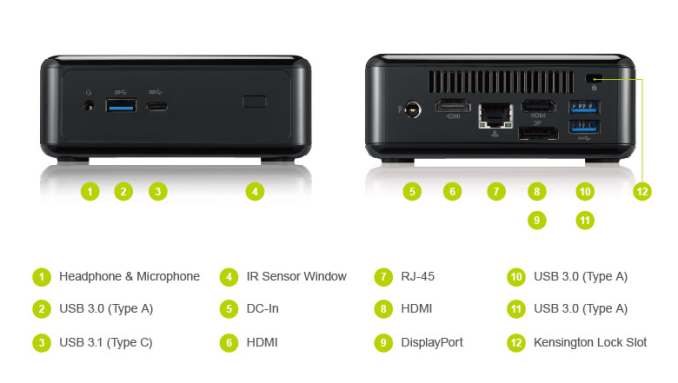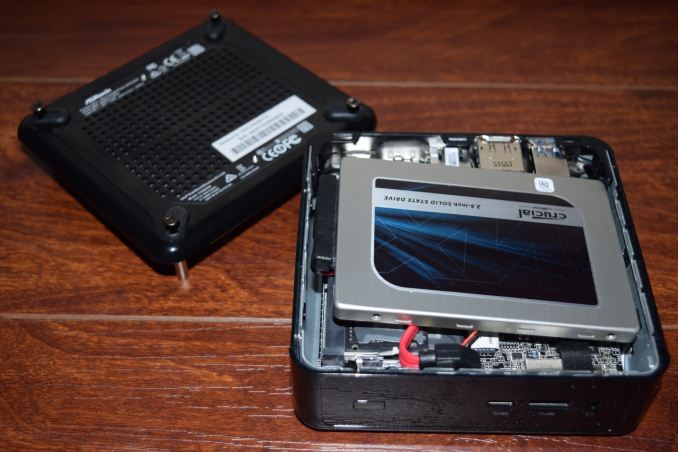ASRock Beebox-S 7200U Kaby Lake UCFF PC Review
by Ganesh T S on February 7, 2017 8:00 AM ESTFinal Words
The benefits delivered by Kaby Lake over Skylake are passable from a performance perspective. That said, the Kaby Lake media engine in the Intel HD Graphics 6xx has moved from lagging behind NVIDIA's VPU to becoming the leader in the space. In addition to HEVC Main as well as Main10 decode support, Intel is also delivering 10-bit VP9 decode. The benefits of the latter are debatable, but, on paper, the Kaby Lake GPU delivers the goods for HTPC users. The MSI Cubi 2 disappointed us a bit on this front by not opting to enable a HDCP 2.2-capable HDMI 2.0 output. This requires a LSPCon (approximately a $2 addition to the BOM according to our industry sources), and ASRock's Beebox-S 7200U integrates one. Kaby Lake's additional DRM capabilities also enable Netflix 4K streaming. All in all, the Beebox-S 7200U is an effective HTPC for casual 4K media consumers - either OTT, or, from local sources.
ASRock also manages to score on some other differentiation aspects - the availability of a USB 3.1 Gen 2 Type-C port, thanks to the ASMedia ASM1142 bridge controller, as well as a compact footprint while retaining support for a 2.5" drive. Unlike some of the other UCFF PCs in the market that opt for Realtek NICs, the Beebox-S 7200U does sport an Intel Gigabit LAN controller.
Positives aside, ASRock still has some scope for improving the Beebox-S. Most of our feedback from the Beebox-S 6200U review are still valid since the chassis design and motherboard components of the Beebox-S 7200U are almost the same (except for the processor and the BIOS).
The internal layout of the unit is very cramped, making even SODIMM installation a bit of a challenge. Installing a 2.5" drive is even more of a pain with the necessity to route the SATA cable and power wires around the SODIMM. While the initial setup issue is a one-time hassle, the effect of the SODIMM heating up on the SATA cable is a bit of a worry. ASRock must shift to a single flexible data/power cable (similar to the one used in the DeskMini 110) to address this issue. Another candidate for addressing is the decision to go with a 1x1 802.11ac WLAN card instead of the 2x2 configuration used by the Intel NUCs.
SATA Wiring Concerns with 2.5" Drives in the Beebox-S 7200U
It is best to use a M.2 2260 SSD in the unit, but, 2280 SSDs are more common. Installing such a SSD is possible, but, requires a separate plastic tab. The M.2 SSD also has no thermal protection support from the chassis design. We also found that the QVL (qualified vendors list) doesn't include many popular NVMe SSDs such as the Toshiba OCZ RD400. Usually, SSDs that are not in the QVL work without problems, but, we found that the Beebox-S 7200U just wouldn't recognize the RD400 in the M.2 slot. To top this, there is definitely some issue with the latest BIOS and the tested Samsung SSD 950 PRO NVMe SSD - the core clocks idle at the maximum rate and the Prime95 torture test occasionally results in thermal runaway and system freezing. Neither of these issues were observed with a 2.5" SATA SSD. Our suggestion to readers contemplating the purchase of a Beebox-S 7300U is to go with a 2.5" SATA SSD instead of a NVMe SSD.
The thermal solution for the processor turns out barely OK - traditional system stability tests keep the temperatures well below Tjmax. However, workloads like Prime95 make the processor enter dangerous territory and the thermal solution can't sustain the 20W package power that the system is configured for. ASRock would do well to make the thermal solution better for the next generation version.
The Beebox-S 7200U is currently available on both Amazon and Newegg for around $350 (though the Amazon first-party listing was backordered when we last checked). The corresponding MSI Cubi 2 and GIGABYTE BRIX models are currently listed at $375 and $391 respectively. Despite the shortcomings that were identified during the course of our review, the Beebox-S provides the best value for money amongst the Kaby Lake UCFF PCs currently in the market.












33 Comments
View All Comments
zepi - Tuesday, February 7, 2017 - link
Did you by any chance test HDR playback over HDMI 2.0 connection to HDR 4K TV?lordmocha - Tuesday, February 7, 2017 - link
According to "7th-gen-core-family-desktop-s-processor-lines-datasheet-vol-1.pdf":2.5.8 describes the CPU display support info:
"The HDCP 2.2 keys are integrated into the processor and customers are not required to physically configure or handle the keys. HDCP2.2 for HDMI2.0 is covered by the LSPCON platform device." (The LSPCON is the 3rd party motherboard soldered down solution.)
DP supports HDCP2.2 with HDR (4k@60 10 bit)
HDMI1.4 does supports HDCP2.2 but NO HDR (4k@30 8 bit)
HDMI2.0 does supports HDCP2.2 but NO HDR (4k@60 12bit (YUV 420))
HDMI2.1 does supports HDCP2.2 with HDR (4k@60 12bit (YUV 420))
2.4.3.1 describes the CPU Hardware Accelerated Video Decode support:
HEVC/H265 (8 bit) Profile: Main, Level: 5.1: Max Resolution: 2160p
HEVC/H265 (10 bit) Profile: Main, BT2020, isolate Dec, Level: 5.1, Max Resolution: 2160p
It does not clarify if these are HEVC Version 1 profiles or HEVC Version 2 profiles. It does says "All supported media codecs operate on 8 bpc, YCbCr 4:2:0 video profiles.".
lordmocha - Wednesday, February 8, 2017 - link
Of note is the CPU maxes out at HEVC level 5.1 whereas the HEVC spec goes up to level 6.2, and videos can be found online using levels above 5.1, thus they won't be able to be hardware decoded.vdpauinfo output would be nice to see
star-affinity - Saturday, February 18, 2017 - link
Hmm... Doesn't sound too good – I mean many people (including me) are probably hoping to playback HVEC encoded videos with GPU acceleration on their Kaby Lake computers. So you're saying this won't work with certain HEVC files over a certain level? I'm not deeply knowledgeable how HEVC works – this about levels is new to me.star-affinity - Saturday, February 18, 2017 - link
Sorry HVEC = HEVC there the first time I mentioned it.mikeroch - Monday, February 20, 2017 - link
Wow, it just look great. I believe it will rock and boost the system of http://http-192-168-1-1.net/DanNeely - Tuesday, February 7, 2017 - link
Is it just weird perspective, or is the computer shown on the packaging a much longer model than the one that was reviewed?BrokenCrayons - Tuesday, February 7, 2017 - link
Like all NUC form factor systems, this one is adorably cute! Cooling looks like its done via the internal fan and movement of air so it's a candidate for a collection of kitten stickers on the outside. Those won't hurt internal temps, I'm thinking because of the case being made from plastic.Too bad about the heat issues. It probably won't be a problem under normal use right from the start, but dust buildup might take its toll over time. I do wish companies overbuilt their cooling systems a bit to tolerate fan slowdown and dust.
fanofanand - Wednesday, February 8, 2017 - link
That would blow up the "planned obsolescence" strategy.BrokenCrayons - Wednesday, February 8, 2017 - link
Does a company really need to do something like that with a NUC box? The CPU is soldered down and the motherboards can't be swapped out so the obsolescence is already implied. Designing and installing effective cooling probably would save a company money on in-warranty returns and build goodwill toward the brand by limiting failures and possible erratic behavior.